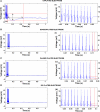Improving impedance of implantable microwire multi-electrode arrays by ultrasonic electroplating of durable platinum black
- PMID: 20485478
- PMCID: PMC2871717
- DOI: 10.3389/fneng.2010.00005
Improving impedance of implantable microwire multi-electrode arrays by ultrasonic electroplating of durable platinum black
Abstract
Implantable microelectrode arrays (MEAs) have been a boon for neural stimulation and recording experiments. Commercially available MEAs have high impedances, due to their low surface area and small tip diameters, which are suitable for recording single unit activity. Lowering the electrode impedance, but preserving the small diameter, would provide a number of advantages, including reduced stimulation voltages, reduced stimulation artifacts and improved signal-to-noise ratio. Impedance reductions can be achieved by electroplating the MEAs with platinum (Pt) black, which increases the surface area but has little effect on the physical extent of the electrodes. However, because of the low durability of Pt black plating, this method has not been popular for chronic use. Sonicoplating (i.e. electroplating under ultrasonic agitation) has been shown to improve the durability of Pt black on the base metals of macro-electrodes used for cyclic voltammetry. This method has not previously been characterized for MEAs used in chronic neural implants. We show here that sonicoplating can lower the impedances of microwire multi-electrode arrays (MMEA) by an order of magnitude or more (depending on the time and voltage of electroplating), with better durability compared to pulsed plating or traditional DC methods. We also show the improved stimulation and recording performance that can be achieved in an in vivo implantation study with the sonicoplated low-impedance MMEAs, compared to high-impedance unplated electrodes.
Keywords: electroplating; impedance; microelectrode arrays; platinum black; stimulation artifact; thermal noise.
Figures









References
-
- Arsiero M., Luscher H. R., Giugliano M. (2007). Real-time closed-loop electrophysiology: towards new frontiers in in vitro investigations in the neurosciences. Arch. Ital. Biol. 145, 193–209 - PubMed
-
- Branner A., Stein R. B., Normann R. A. (2001). Selective stimulation of cat sciatic nerve using an array of varying-length microelectrodes. J. Neurophysiol. 85, 1585–1594 - PubMed
LinkOut - more resources
Full Text Sources
Other Literature Sources

